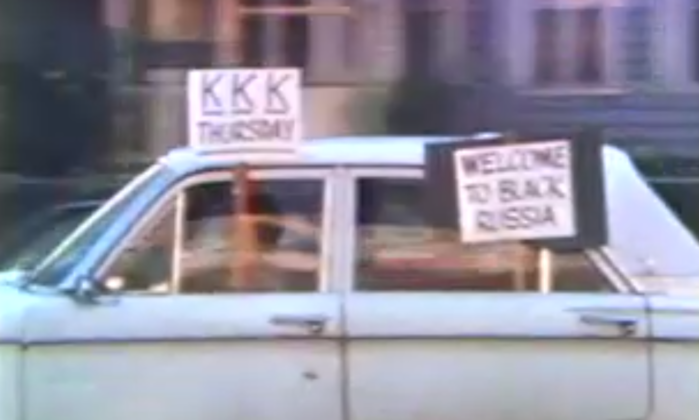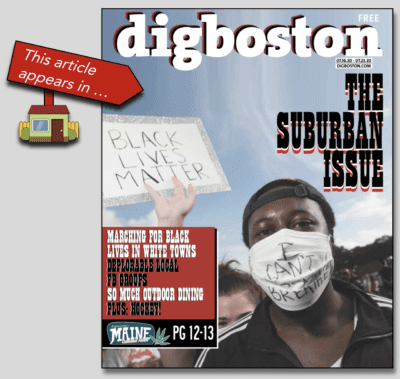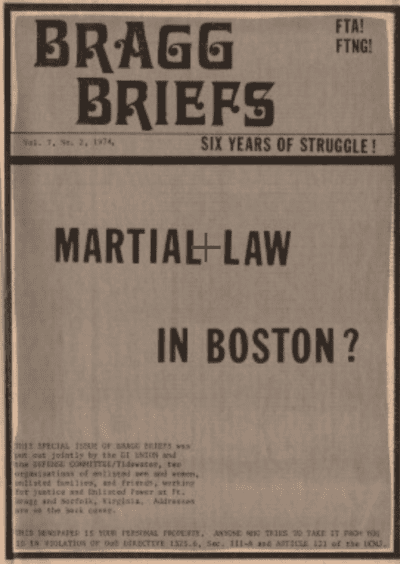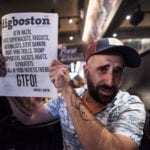
Dear Reader,
As some of you may recall, we have a rather unique “unnaming” policy at DigBoston, which basically means that we don’t pay too much attention to bigots, racists, nitwits, and trolls.
Of course, that doesn’t mean that we ignore them. Or their presence in this city since… well, since the nation’s first news sheets were inked here 300 years ago.
 In this week’s issue, we look out to the suburbs and the impact and reverberations that ongoing protests and police reform efforts have had on bedroom communities as well as cities beyond Boston. And since we’re attempting to understand why there is so much hate brewing in the ’burbs, we’ll want to go back in time, if not all the way to when Black people were bought and sold in Faneuil Hall, then at least to the outrageous 1970s. In service of that prerequisite, and in the interest of unearthing and amplifying relevant history, I dug up this revealing portrait of the moment from a November 1974 issue of the underground newspaper Revolution:
In this week’s issue, we look out to the suburbs and the impact and reverberations that ongoing protests and police reform efforts have had on bedroom communities as well as cities beyond Boston. And since we’re attempting to understand why there is so much hate brewing in the ’burbs, we’ll want to go back in time, if not all the way to when Black people were bought and sold in Faneuil Hall, then at least to the outrageous 1970s. In service of that prerequisite, and in the interest of unearthing and amplifying relevant history, I dug up this revealing portrait of the moment from a November 1974 issue of the underground newspaper Revolution:
Mayor White sent large numbers of police out to South Boston, allegedly to protect Black children. But bystanders reported that in many cases, police actually encouraged rock throwing and allowed groups of assailants through their lines, while also using the opportunity to come down hard on some of the white teenagers and bystanders.
At the same time, the Ku Klux Klan (KKK) began to play an open role in the organized opposition to the busing–in part through harassing Black and Latin residents of Columbia Point, a housing project near South Boston. Six Klan members fired some shots into the project on Sept. 21 and were met by a return volley. Columbia Point residents knew that they could not rely on the cops to protect them, and that they had to defend themselves. So they organized self-defense committees in the project.
In response to the organization of these groups, and using the shooting as a justification and anger at the busing plan in the white community as an avenue of support, the city government sent in 300 police. The cops, equipped with M-16s and M-1s, occupied the project, attacking tenants and looting ’ apartments, supposedly looking for weapons.
Point residents and Black communities throughout the city and some working people of all nationalities started organizing in response. Three days later, the police were withdrawn from the Columbia Point Christian Center, which was headquarters for the self-defense. But a significant force remained on rooftops for weeks.
 In addition to learning about the disgraceful events that seeded the current state of unchecked brutality and horror, looking through alternative media clippings about police in Boston a lifetime ago, a passage from a 1974 issue of Bragg Briefs forced me to stop and compare then to now. Published by GIs United Against the War in Viet Nam, the edition condemned “Martial+Law in Boston” and railed against the “racist hysteria” Black people faced in the Hub:
In addition to learning about the disgraceful events that seeded the current state of unchecked brutality and horror, looking through alternative media clippings about police in Boston a lifetime ago, a passage from a 1974 issue of Bragg Briefs forced me to stop and compare then to now. Published by GIs United Against the War in Viet Nam, the edition condemned “Martial+Law in Boston” and railed against the “racist hysteria” Black people faced in the Hub:
The pattern is the same: the cops, the newspapers, and politicians all conspire to whip up racist fears in the White communities, and then come down on the Blacks. The papers make a lot of money, the politicians win their elections, and the cops get more power in the communities.
In a lot of ways, that pattern remains the same today. Much of our coverage of the suburbs shows elements of the same exact problems.
At the same time, while negative and irresponsible reporting still persists, there are also lots of journalists flipping the script. And though I’m sad to say it, it’s no longer the case that the papers make a lot of money, nor are cops (necessarily) getting more power, at least not without having to fight for it in public.
Before I run the risk of appearing too cheerful, I’ll finish with the inspiration for this column. In researching the history of separatist nuts in the Hub out of curiosity last week, I noticed that a lot of articles penned in the decades since, looking back on ’74, have read something like, When the Klan came to Boston …
As if they used to be in the vicinity and then moved to other countries and remote islands.
Nah, they’re still right here, in a Massachusetts city, town, or suburb near you.
CHRIS FARAONE, EDITOR-IN-CHIEF
A Queens, NY native who came to New England in 2004 to earn his MA in journalism at Boston University, Chris Faraone is the editor and co-publisher of DigBoston and a co-founder of the Boston Institute for Nonprofit Journalism. He has published several books including 99 Nights with the 99 Percent, and has written liner notes for hip-hop gods including Cypress Hill, Pete Rock, Nas, and various members of the Wu-Tang Clan.


